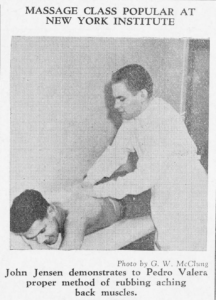Chiropractic was unlicensed in New York State, so at age 31, Dad decided to move his practice elsewhere. He first hopped on a bus to Miami, slept on the beach there, and decided Miami wasn’t for him. He tried Denver next, and ran into another chiropractor who needed help with his practice. Dad joined the practice, and his parents soon followed him there. Things looked promising until Dad found out that the other chiropractor was tainting patient samples with food coloring. Now broke, Dad decided to give California a try.
Grandma and Grandpa followed along, landing in Venice Beach where Grandpa, going blind from diabetes, sold flowers on the street. Grandma also worked. Dad had to go back to college to pick up some credits for licensing. He enrolled in a small chiropractic college in Hollywood while he lived in a rooming house and subsisted on peanut butter sandwiches. He met another chiropractor named Hansen there and they started a practice together on Hawthorne Blvd, across from the Hawthorne Grill (of Pulp Fiction fame). At that point Dad was 33. Hansen was handy as a sighted partner, but he wasn’t around much, and he eventually left the practice entirely.
Grandma and Grandpa got an apartment 6 or 8 blocks away in Lawndale. Grandma would dress in white and help out as a receptionist, or in whatever way she could. Dad was pulling in $400 per week, and he felt rich. He was also an active member of the Los Angeles Bahá’í community, one of the largest and most distinguished Bahá’í communities in the world. With the death of the Guardian, it was a dark time for Bahá’ís, but they would soon recover.

